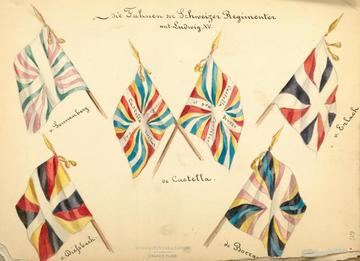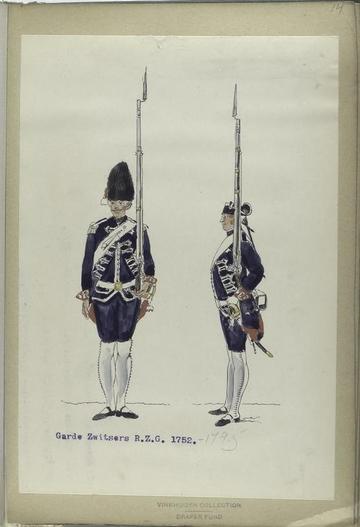Cooperation amidst Competition. Europe’s Fiscal-Military System and the Nationalisation of Warfare 1530-1870

Flags of Swiss regiments serving Louis XV of France (Vinkhuijzen Collection, New York Public Library)
There are few areas of human existence that do not involve cooperation, yet we tend to regard warfare as a purely violent and competitive phenomenon which divides people into hostile parties. Of course, people must cooperate to fight because warfare requires organisation and direction. For most of human history it has been the state which has provided this organisation and coordination, and consequently many scholars view warfare and state formation as symbiotic. However, there is considerable evidence in today’s world that this is no longer the case, since few states can fight without assistance and even the most potent war-maker, the United States of America, relies heavily on private military contractors and arms producers who are global actors in their own right. The current situation has important historical precedents which have been almost entirely overlooked, primarily due to the way that political and military history has been written as part of a broader process of forming modern, sovereign states. The context has certainly changed, but just as today’s ‘postmodern’ and at least partially ‘post-sovereign’ states rely on a host of non-state actors to fight and project their power, such cooperation with outsiders was integral to the emergence of modern states.
These reflections inform what is intended as the overarching book from the ERC-funded European Fiscal Military System 1530-1870 project. Its core objective is to understand the place of cooperation in the violent process of forming modern states and to examine how it was possible to obtain the necessary resources from those who might be ambivalent or even enemies. It builds on the project’s six case studies, as well as the dataset of over 1,000 subsidy treaties and agreements for the hire of auxiliary troops compiled by the research team, and additional examples and evidence. The book is under contract with Oxford University Press towards the end of 2024 for publication both in physical copy and as an open access monograph of 125,000 words.

The Swiss Guard Regiment in Dutch service 1752-95 (Vinkhuijzen Collection, New York Public Library)
After an introductory chapter setting out the historiographical context, three thematic chapters will examine (i) the key war-making assets, (ii) the wide variety of sovereign, semi sovereign and non-state actors involved in producing, distributing, and consuming these resources across political boundaries, and (iii) the hubs, or urban centres where such transactions were arranged. These chapters define assets, actors, and hubs, and compare their development and role across Europe, as well as exploring the specific types of contract and other instruments involved in the transfer of war-making resources. The discussion assesses how those involved sought to establish trust and mitigate risk, as well as evaluating how far their activities can be classified simply as ‘business’. Detailed examples illustrate how the system functioned, often imperfectly. Collectively, these three chapters argue that this form of cooperation became sufficiently dense and extensive as to constitute what can properly be called a ‘fiscal-military system’ in the accepted definition of a regularly interacting or interdependent group of items forming a unified whole.
The following nine chapters explore the system’s emergence, consolidation, maturity, zenith, and ultimate decline and dismantling in chronological sequence. Particular attention is paid to demarcating what distinguished developments after around 1530 from earlier medieval antecedents, highlighting what was new, as well as some parallels and continuities. Changes in scale and involvement will be illustrated quantitatively primarily through analysis of the use of foreign military labour and finance, with additional examples drawn from the other four asset categories. Spatial variations are also addressed by examining how Europe’s numerous polities became integrated to varying degrees within the system, most notably through the partial inclusion of both Russia and the Ottoman empire by the later eighteenth century. The discussion will highlight shifts in the interrelationship between the different elements of the system, as well as how these were related to the gradual delineation of political power in the form of sovereign states. The progressive elimination of semi-sovereign entities after the 1790s forms an important part of the explanation for the system’s decline and eventual disappearance. The question of ‘success or failure’ will be explored in relation to the varied objectives of those involved. A final concluding chapter reflects on the implications of the projects’ findings for theories of state formation and resource mobilisation.
The era of fully nationalised, modern warfare has proved historically comparatively brief, giving way around 1990 to a postmodern, increasingly post-national war making which is more dependent on private military and security companies and in which armed non-state actors have assumed considerable importance. Contemporary conditions do not represent a ‘return of the mercenary’ or any other allegedly pre-modern forms, but nonetheless, an examination of the significance of early modern extra-territorial resource mobilisation provides a valuable long-term perspective and can help us pose better questions about the present.
'Cooperation amidst Competition. Europe’s Fiscal-Military System and the Nationalisation of Warfare 1530-1870' by Peter H. Wilson will be published by Oxford University Press in 2024.


